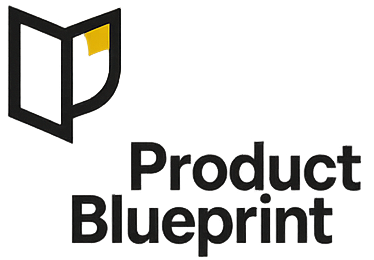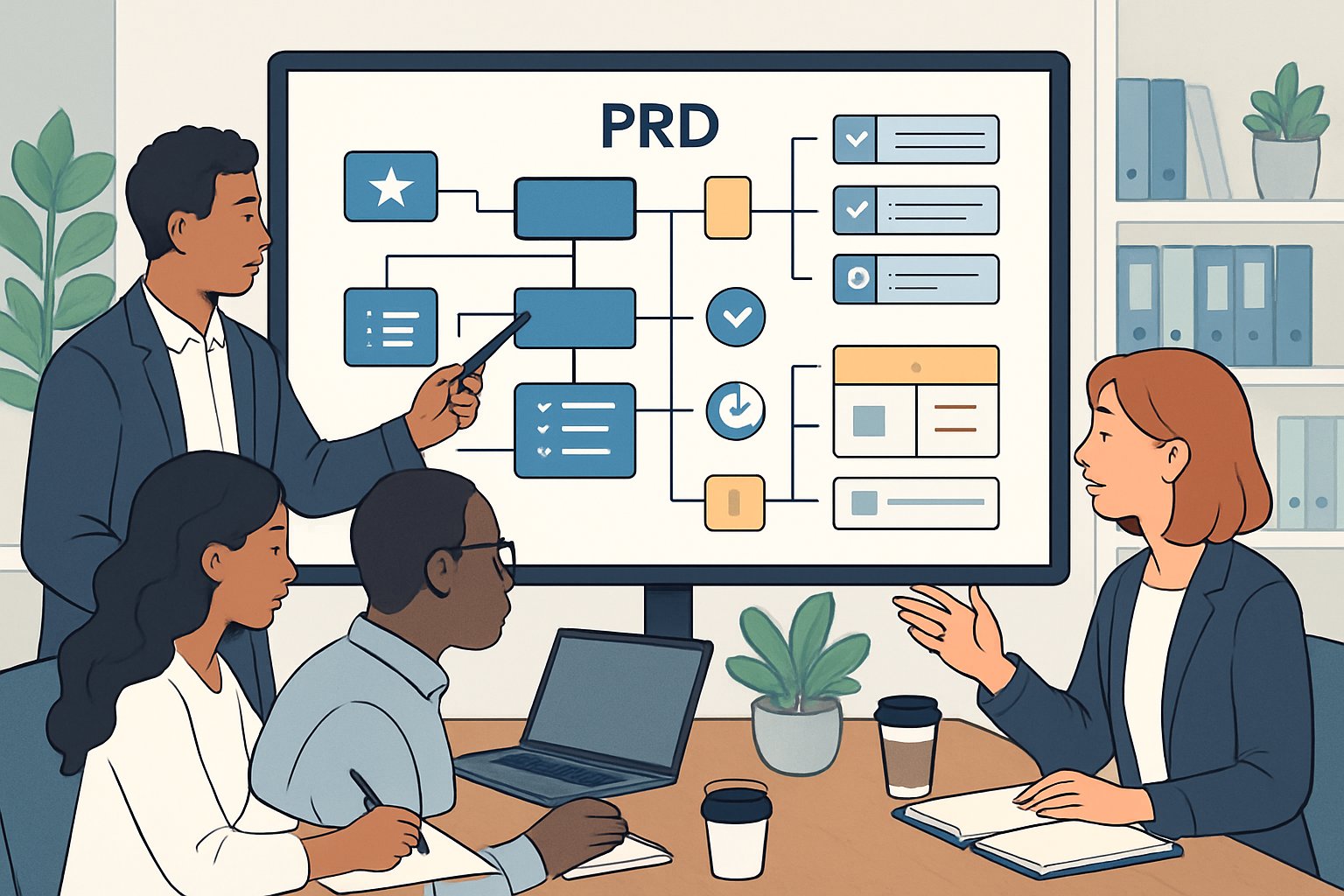TL;DR
We need a minimum doc set that covers PRD to rollout without gaps. Let’s skip the binder approach—nobody wants that.
Our 7-part PRD skeleton includes:
- Problem & outcomes
- Users & use cases
- Scope
- Acceptance criteria
- Non-functional & guardrails
- Analytics plan
- Rollout & rollback
We make acceptance criteria testable and analytics measurable. Guardrails cover privacy, accessibility, security, and fair design as non-negotiable items.
We ship behind feature flags using a preflight checklist and a one-click rollback system.
Key definitions (one line each)
PRD: A short doc that states the problem, expected outcomes, and what must be true when we release the product.
Acceptance criteria: Pass or fail tests that prove we met a requirement.
Analytics plan: The events, metrics, dashboards, and team members who measure success and safety limits.
Guardrails: Safety rules for privacy, accessibility, security, and fairness that we must follow.
Feature flag: A control switch that lets us choose which users see new features.
Rollback: A tested way to quickly turn off or undo changes if problems happen.
Objective/KR: The goal our work aims to reach, like increasing user sign-ups by 4% this quarter.
Why a minimum doc set beats heavy specs
Teams move faster with focused docs. We need four key pieces: intent explaining why we build something, definition of done showing what success looks like, evidence for measuring results, and safety plans for problems.
Heavy specs slow product development. Teams waste time writing pages nobody reads.
Simple docs improve communication between team members.
A tight doc set gives us speed now and clear records later.
The PRD skeleton (7 sections that scale)
A product requirements document uses seven core sections that work for any software feature.
These sections scale from small updates to major product launches.
Problem & outcomes defines the user problem in one sentence. We include the objective and key result with baseline and target metrics like “Activation 40% → 46% in 90 days.”
Users & use cases covers who the feature serves and the top three use cases.
We link to designs when available to show the complete picture.
Scope & UX snapshot separates must-have capabilities from what we won’t build now.
We include one flow diagram or link to show the user experience.
Acceptance criteria lists 5-10 testable statements that QA can verify.
We cover empty states, error handling, and permission checks.
Non-functional & guardrails addresses performance, security, privacy, accessibility, and fairness requirements for the product development process.
Analytics plan outlines events, properties, primary metrics, and guardrail metrics.
We include dashboard links and assign owners.
Rollout & rollback covers feature flags, user cohorts, communication plans, and support preparation.
We define rollback triggers and data cleanup steps.
Step-by-step playbook: PRD → rollout
1) Align on outcomes
Start by writing the Objective/KR and guardrails first. Define clear KPIs that show what success looks like.
Example KR: D30 retention 22% → 26%. Set a guardrail like accessibility defects ≤ 0.5/1k MAU.
This creates success metrics that everyone agrees on before we build anything.
2) Draft the PRD skeleton
Fill all 7 sections using bullets. Note open questions and assign owners for each section.
Include user stories and use cases that explain who needs this feature.
Break large features into smaller epics. Keep it simple and focus on the core problems we’re solving.
3) Write acceptance criteria
Use Given/When/Then format or simple pass/fail bullets. Cover all edge cases including empty states and error states.
Add role and permission cases for different user types. This helps developers know exactly what to build.
4) Build the analytics plan
Name all events, properties, metrics, and dashboards. Assign owners for instrumentation and analysis.
Add quick sizing calculations to estimate the work needed.
5) Preflight: guardrails & reviews
Run privacy checks including data maps and retention policies. Complete accessibility WCAG 2.1 AA reviews.
Check security and reliability with SLO reviews. Make sure alerts are ready.
6) Plan the rollout
Use feature flags: internal → 5% → 25% → 50% → 100%. Pick safe cohorts like new users or low-risk regions.
Prepare support macros and stakeholder communications.
7) Prove rollback works
Document clear triggers like complaint rate > 0.3% or error rate > 0.5%.
Test one-click disable in staging and production. Name the on-call owner who can make rollback decisions during launch.
Trade-offs: heavy docs vs minimum vs none
| Approach | Pros | Cons | Use when |
|---|---|---|---|
| Heavy docs | Thorough; audit-friendly | Slow; stale quickly | Regulated/complex programs |
| Minimum doc set | Fast; aligned; auditable | Needs discipline to stay current | Most product work |
| No docs | Quick to start | Misalignment; rework; no trail | Tiny, reversible tweaks |
Each approach has clear benefits and drawbacks. Heavy documentation prevents scope creep but takes time.
Quick calculation (drop-in for the PRD)
We use a simple formula to estimate project impact within our 90-day timeline:
Expected KR contribution (units) = Reach × Baseline × Lift × Confidence
Reach equals users touched in the 90-day window. Baseline shows current success rate from 0 to 1.
Lift represents expected relative change like +10% = 0.10. Confidence uses 0.25, 0.5, or 0.8 based on evidence strength.
Example calculation: Reach 50,000 new users, Baseline 0.40, Lift 0.10, Confidence 0.7 →
50,000 × 0.40 × 0.10 × 0.7 = 1,400 incremental activations in 90 days.
We apply this method to stack-rank ideas and establish go/no-go thresholds during rollout.
This helps us prioritize which milestones to tackle first based on expected returns within our budget constraints.
B2B example (≤5 lines): audit exports for enterprise SaaS
We built audit export features for our enterprise customers. Marketing teams can now tell stakeholders about reduced audit pain points.
The target market includes 200 enterprise logos where 30% need monthly exports.
Our UX delivers exports in under 60 seconds with masked PII data.
This improved user experience helps us save 36 accounts per quarter. We reduced churn from 3.2% to 2.6% by solving audit compliance needs.
B2C example (≤5 lines): streaks with rest-day rules
We built streak functionality to keep new users engaged past week three. Our target was increasing 30-day retention from 22% to 26%.
Designers created mockups showing streak counters that cap at six days out of seven.
Engineers built pause features for rest days with VoiceOver labels. Developers added optional haptic feedback during prototyping.
We track streak_started, streak_broken, and workout_completed events.
Our rollout targets 10% of new iOS users. We expect 1,320 additional retained users from this feature.
Paste-ready PRD skeleton
This PRD template gives you a simple framework for product requirements. Just copy and paste this structure to kick off your next project doc.
Header Format:
PRD: < Feature/Project Name > | Owner: < Name > | Date: < YYYY-MM-DD >1) Problem & outcomes
- Problem: < 1–2 lines >
- Objective/KR: < Metric baseline → target in 90 days >
- Expected contribution: Reach × Baseline × Lift × Confidence = < value >
2) Users & use cases (JTBD)
- Primary user(s): < role/segment >
- Top use cases (≤3): < bullets >
3) Scope (in/out) & UX snapshot
- In: < must-haves >
- Out: < won’t do >
- UX: < link to designs/one flow >
4) Acceptance criteria (testable)
- < Criterion 1 >
- < Criterion 2 >
- < Edge case/error/permission >
5) Non-functional & guardrails
- Performance/SLO: < e.g., p95 < 600 ms >
- Privacy/Security: < data map, retention, lawful basis >
- Accessibility: < WCAG 2.1 AA checks >
- Fairness/Non-manipulative growth: < notes >
6) Analytics plan (success & guardrails)
- Events & properties: < list >
- Primary metric: < name/definition >
- Guardrails: < complaint rate, a11y defects, error rate >
- Dashboard & owner: < link / name >
- Decision threshold: < e.g., +2 pp vs control after 2 weeks >
7) Rollout & rollback
- Flags & cohorts: < internal → 5% → 25% → 50% → 100% >
- Comms & support: < macros, status page >
- Rollback trigger & switch: < thresholds > | < one-click disable >
- Data cleanup: < what to delete/revert >
Paste-ready rollout checklist (preflight)
Flags: Double-check that cohort targeting works. Confirm exposure ramps.
Observability: Make sure logs, alerts, and dashboards are live. Owners should be on call.
Runbook: Decision makers, rollback steps, and comms templates need to be ready.
Support: Brief your team on macros, FAQs, and any known limits.
A11y/Privacy/Security: Pass all checks. Update DPAs and data maps.
Kill switch: Test it in both staging and prod.
Guardrails & ethics (must-pass gates)
We ask every release to pass five critical checks before launch. Privacy means collecting the bare minimum and sticking to legal storage and deletion rules.
Accessibility standards help everyone use our products—contrast, labels, and keyboard navigation matter.
Security keeps user data safe with encryption and regular threat checks. We stamp out dark patterns that try to trick users with consent or cancellation.
Reliability means our systems can handle errors and roll back if needed. If something fails, we stop the release—no exceptions.
Pitfalls & better alternatives
Product management stumbles into some classic traps. These mistakes drain resources and hurt outcomes.
Feature-first PRDs with no outcomes just waste time. Let’s start with Objective/KR and expected contribution instead.
Vague acceptance criteria confuse everyone. Make them binary and cover edges and permissions.
Analytics as an afterthought leaves you in the dark. Define events before you build, and pick a dashboard owner early.
Skipping guardrails is asking for trouble. Run privacy/a11y/security preflight checks and block if anything fails.
Big-bang launches are risky. Use flagged rollout with thresholds and tested rollback plans.
No rollback plan leaves you stuck. Write down triggers, switch, and cleanup steps, and actually test them.
Mini FAQ
How long should the PRD be? Keep it short—aim for 2-4 pages. If you need more space, just link out to extra details instead of cramming everything in.
Where do dates live? Put all your dates in the delivery plan. The PRD and rollout should talk about outcomes and safety, not specific deadlines.
Do I need RICE or WSJF here? Use those frameworks to prioritize before you start writing the PRD. Inside the PRD, focus on expected contribution and guardrails.
What if the metric doesn’t move? Stop and take a closer look. Either kill the project or try a different approach, and make sure you update the doc so there’s always a record.
Who owns analytics and guardrails? Pick a clear metric owner and a guardrail owner in the PRD. When everyone’s responsible, no one really is.
Product managers need a PRD process that’s minimal and disciplined. You want speed, but you can’t lose sight of safety.





